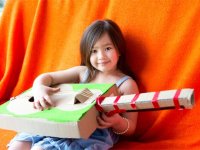Simple Music Integration for Primary Classrooms
Today, we're sharing five easy ways for primary teachers to integrate music into their classrooms. Each activity is specifically designed for individuals of all backgrounds and abilities, and none require musical training or experience.
So why use music in your primary classroom? Well-designed music activities can deepen and reinforce knowledge and skill development across a wide range of subjects. Music is engaging, fun, and can motivate even the most detached students.
Activity 1: Use music for transitions.
Use music to structure daily classroom activities and give directions. This activity engages students and develops their impulse control and self-regulation.
How to Do It
Select a familiar melody and substitute traditional lyrics with simple instructions. For example, sing the following to the tune of "Mary Had a Little Lamb" while lining up at the door:
If students need more time to complete the task, simply repeat the last line. Don't worry about rhyming or words. It's OK to simply repeat the instruction "line up at the classroom door" multiple times.
If singing isn't your thing, you can rhythmically chant your instructions while tapping a steady beat or clapping your hands. Students tend to naturally respond to tempo changes in both singing and tapping, so you can regulate the pace of the activity and student response.
Activity 2: Create a sound lab with found-object instruments.
Sound labs use found objects to create unique instruments. This activity encourages analytic skills, creativity, and sound discrimination.
How to Do It
Raid the recycling bin! Find a wide variety of objects and ask students how that object might be used as an instrument. Plastic yogurt containers, metal coffee cans, cardboard cereal boxes, you name it. Stretch several rubber bands to different lengths. Pluck each one and compare the sound. What does the metal coffee can sound like when you tap it with a pencil? How else can you play your coffee can drum to create a different sound? Once your collection is assembled, sort into categories, such as wood, plastic, paper, and metal. The categories themselves are less important than the recognition of the process.
Tip: To add another level of excitement, play along to popular kids songs.
Activity 3: Compose a soundtrack for a favorite classroom book.
Compose your own simple soundtrack to reinforce pre-literacy skills such as parts of a story, sequencing, and phonemic awareness. As a bonus, students begin to connect events in the story and understand that musical elements can also tell a story.
How to Do It
Select a favorite classroom book. Read a page or two and then ask students to make sounds that go along with the narrative. For example, if a character is walking through the woods, say, "Make the sounds of Little Red Riding Hood’s footsteps." Establish a cue to stop the sound. Easy, common sounds include anything weather-related (wind, rain), animal sounds, or even moving vehicles (trains, airplanes). Modify or extend the activity to include the use of classroom or found-object instruments (see Activity 2).
Activity 4: Learn a few basic conducting patterns.
Learning a few basic conducting patterns encourages pattern recognition and numeracy skills from simple motions. It develops physical coordination, listening, teamwork, and cooperation.
How to Do It
This one is a little more involved, but it's well worth the effort. Explain that conductors lead musicians to help them understand the pattern of beats so that they can all work together. This short video explains what conductors do.
Then tell students that it's their turn to conduct! Using their finger or a single chopstick (a great substitute for a conductor's baton), practice tracing some basic conducting patterns in the air.
You can project this visual (or a similar one), and ask students to start at the top of the image and move with the shape. From the visual, a 2/4 time signature is a two-part image and movement. Start by saying "down, up" as you move, and then switching to "one, two." For a 3/4 time signature, say "down, over, up," and then "one, two, three." For 4/4, begin with "down, over, across, up," switching to "one, two, three, four."
Use language to reinforce correct patterns. Once students feel comfortable with a pattern, try conducting along to a favorite song. Take turns, asking each student to conduct the others while playing instruments or singing. "Mary Had a Little Lamb" or "Baa Baa Black Sheep" work for 2/4. "Rock-a-Bye Baby" is in 3/4. "Twinkle, Twinkle" is great for 4/4. If students deem these songs too easy, challenge them to write different lyrics. If you have a bunch of aspiring pop stars, conduct along to "Uptown Funk" or "Lean on Me" for 4/4.
Activity 5: Get out the parachute and find "big" and "little" beats.
Have you used a classroom "parachute" before? This oversized, colorful piece of fabric can be a great addition to any class activity. If you don't have one, a large bedsheet or colored scarves can also do the trick!
Parachute work is a great outlet for energy and kinesthetic movement. In addition to being a favorite for many students, it can help develop self-regulation, coordination, and teamwork when applied to a rhythmic pattern.
How to Do It
Tell students that they must find the "big" and "little" beats with the parachute. Sing a classroom song or listen to some favorite recorded music. First move with bigger, slower movements (corresponding with the half note value), and then switch over to smaller, more frequent ripples with the parachute (corresponds with quarter note). Go back and forth between big and little. With this activity, students are simply doubling their movements or cutting them in half. You can do extra big beats (whole notes) or teeny-tiny beats (eighth notes) if you feel like students are ready for a challenge.
How do you use music in your classroom? Please tell us about it below in the comments.
